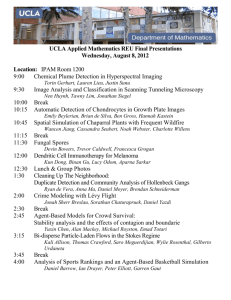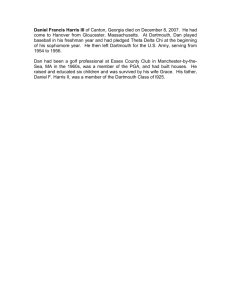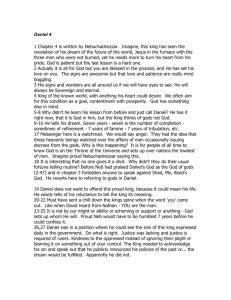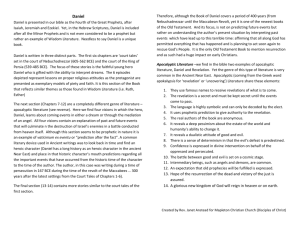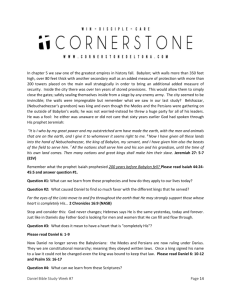The Book of Daniel - BattleCry Ministry
advertisement
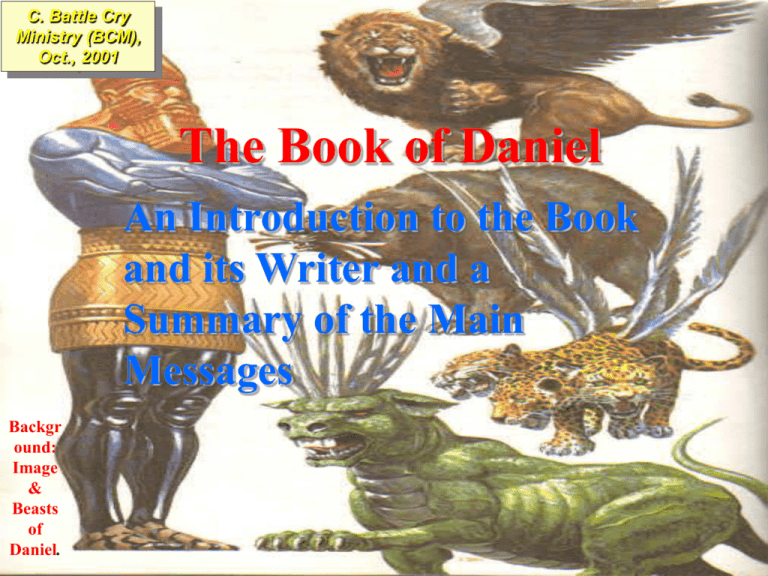
C. Battle Cry Ministry (BCM), Oct., 2001 The Book of Daniel An Introduction to the Book and its Writer and a Summary of the Main Messages Backgr ound: Image & Beasts of Daniel. • Daniel was told to close the book he wrote (Daniel 12:4). However, the book is no longer a closed book, because God told Daniel “shut up the words and seal the book even to the time of the end.” All serious Bible scholars agree that the condition for the opening of the book has been met, for we are indeed in the “time of the end”(Matthew 24). Indeed, it will soon be the “end of time”. Introduction • • • • • The Book of Daniel: (i) Who was Daniel? (ii) When was the book written? (iii) Daniel as a prophet. (iv) The book’s authenticity. Who was Daniel? • “Daniel” means “God is my judge” OR “Judge of God”. • (1) David’s second son, born unto him in Hebron, of Abigail the Carmelitess (he is also called Chileab - 2 Sam. 3:3; Other Daniel ref.: Ezra 8:2; Neh.10:6). • (2) One of the four great prophets although he is not once spoken of in the Old Testament as a prophet. • Daniel was descended from one of the noble families of Judah (Daniel 1:3) and was probably born in Jerusalem about 623 B.C., during the reign of Josiah. At the first deportation of the Jews by Nebuchadnezzar (the kingdom of Israel had come to an end nearly a century before), or immediately after his victory over the Egyptians at the second battle of Carchemish, in the fourth year of the reign of Jehoiakim (606 B.C.), Daniel and three other noble youths were carried off to Babylon along with some of the vessels of the Temple. • There, he was obliged to enter into the service of the king of Babylon, and in accordance with the custom of the age, received the Chaldean name of “Belteshazzar”, i.e. “Prince of Bel” OR “Bel protect the king” • His residence in Babylon was very probably in the palace of Nebuchadnezzar. His training in the schools of the wise men in Babylon (Dan. 1:4) was to fit him for service to the empire. • He was distinguished during this period for his piety and his strict observance of the Mosaic law (Dan. 1:8-16), and gained the confidence and esteem of those who were over him. • His habit of attention gained during his education in Jerusalem enabled him soon to master the wisdom and learning of the Chaldeans, and even to excel his compeers. • At the close of his three years of discipline and training in the royal schools, Daniel was distinguished for his proficiency in the “wisdom” of his day, and was brought out into public life. He soon became known for his skill in the interpretation of dreams • (Dan. 1:17; 2:14). • Daniel rose to the rank of governor of the province of Babylon, and became “chief of the governors” (Chald. Rabsignin) over all the wise men of Babylon. • He made known and also interpreted Nebuchadnezzar’s dream; and many years afterwards, when he was now an old man, amid the alarm and consternation of the terrible night of Belshazzar’s impious feast, he was called in at the instance of the queen-mother (perhaps Nitocris, the daughter of Nebuchadnezzar) to interpret the mysterious handwriting on the wall. • He was rewarded with a purple robe and elevation to the rank of “third ruler.” The place of “second ruler” was held by Belshazzar as associated with his father, Nabonidus, on the throne (Dan. 5:16). Daniel interpreted the handwriting, and “in that night was Belshazzar the king of the Chaldeans slain.” • After the taking of Babylon, Cyrus, placed Darius (q.v.), a Median prince, on the throne, during the two years of whose reign Daniel held the office of first of the “three presidents” of the empire, and was thus practically at the head of affairs, no doubt interesting himself in the prospects of the captive Jews (Dan. 9), • whom he had at last the happiness of seeing restored to their own land, although he did not return with them, but remained still in Babylon. Vocal Union - Homesick • His fidelity to God exposed him to persecution, and he was cast into a den of lions, but was miraculously delivered; after which Darius issued a decree enjoining reverence for “the God of Daniel” (Dan. 6:26). He “prospered in the reign of Darius, and in the reign of Cyrus the Persian,” whom he probably greatly influenced in the matter of the decree which put an end to the Captivity (536 B.C.). • He had a series of prophetic visions vouchsafed to him which opened up the prospect of a glorious future for the people of God, and must have imparted peace and gladness to his spirit in his old age as he waited on at his post till the “end of the days.” • The time and circumstances of his death are not recorded. He probably died at Susa, about eighty-five years of age. • Ezekiel, with whom he was contemporary, mentions him as a pattern of righteousness (Ezek. 14:14, 20) and wisdom (Ezek. 28:3). The Book of Daniel: • Is ranked by the Jews in that division of their Bible called the Hagiographa (Heb. Khethubim). It consists of two distinct parts. The first part, consisting of the first six chapters, is chiefly historical; and the second part, consisting of the remaining six chapters, is chiefly prophetic. The Book of Daniel • HAGIOGRAPHA • [HAG ee AHG ruh fuh] (holy writings)-- the third division of the Hebrew Bible. The other two divisions are the Law and the Prophets. Also known as the Writings, the Hagiographa contained 11 books • (13 in the English Bible) in the following order in the Hebrew Bible: Psalms, Proverbs, Job, Canticles (Song of Solomon), Ruth, Lamentations, Ecclesiastes, Esther, Daniel, Ezra, Nehemiah, and 1 and 2 Chronicles. • • (from Nelson's Illustrated Bible Dictionary) (Copyright (C) 1986, Thomas Nelson Publishers) • The historical part of the book treats of the period of the Captivity. Daniel is “the historian of the Captivity, the writer who alone furnishes any series of events for that dark and dismal period during which the harp of Israel hung on the trees that grew by the Euphrates. Psalm 137:1-6 • His narrative may be said in general to intervene between Kings and Chronicles on the one hand and Ezra on the other. • The prophetic part consists of three visions and one lengthened prophetic communication. The Genuineness of the Book of Daniel • The genuineness of this book has been much disputed, but the arguments in its favor fully establish its claims. • (1)We have the testimony of Christ (Matt. 24:15; 26:64) and his apostles • (1 Cor. 6:2; 2 Thess. 2:3) for its authority; and • (2) the important testimony of Ezekiel (Ezek.14:14, 20; 28:3). • (3) The character and records of the book are also entirely in harmony with the times and circumstances in which the author lived. • (4) The linguistic character of the book is, moreover, just such as might be expected. Certain portions (Dan. 2:4; 7) are written in the Chaldee language; and the portions written in Hebrew are in a style and form having a close affinity with the later books of the Old Testament, especially with that of Ezra. • The writer is familiar both with the Hebrew and the Chaldee, passing from the one to the other just as his subject required. • This is in strict accordance with the position of the author and of the people for whom his book was written. That Daniel is the writer of this book is also testified to in the book itself • (Dan. 7:1, 28; 8:2; 9:2; 10:1, 2; 12:4, 5). • In the book of Daniel, Daniel had five visions: • 1. The repetition of Nebuchadnezzar’s dream (Dan. 2:19). • 2. The vision of the four beasts, little horn and judgement scene (Dan. 7). • 3. The vision of the two beasts, little horn and 2300 days (Dan. 8). • 4. The seventy weeks (Dan. 9). • 5. The history of God’s people till the end of time (Dan. 10 - 12). We shall wear a crown - #1, Vocal Union Jesus the Supreme Sculptor (The Great Image of Daniel) • In a dream, King Nebuchadnezzar of Babylon saw a frightening image, consisting of five different types of metal. The head was of fine gold, the breast and arms of silver, the abdomen and thighs of bronze, the legs of iron, and the feet of iron and clay • (Dan. 2:32-33). • These materials, representing four world empires, were inferior in quality from the head downward, terminating in clay. While the king was thinking about the meaning of the image, a stone broke loose from the mountains, struck against the lowest part of the image, broke the whole statue into pieces, and ground all of its material to powder (Dan. 2:34-35). • The stone - “in the days of these kings shall the God of Heaven set up a kingdom, which shall never be destroyed.” (Daniel 2:35,44,45) • Nebuchadnezzars dream, as interpreted by the prophet Daniel, symbolized the ultimate end of Gentile world power at the second coming of Christ • (Daniel 2; 7; Rev. 16:19). • One widely held view is that the four kingdoms represented by his dream were Babylon, MedoPersia, Greece, and Rome. The stone that struck the image and became a great mountain symbolized the triumphant return of Christ as King of kings and Lord of lords (Dan. 2:35,44). • • (from Nelson's Illustrated Bible Dictionary) (Copyright (C) 1986, Thomas Nelson Publishers) • Stone: • In Dan. 2:45 it refers also to the Messiah. He is there described as “cut out of the mountain.” • Rock • (Heb. tsur), employed as a symbol of God in the Old Testament (1 Sam. 2:2; 2 Sam. 22:3; Isa. 17:10; Ps. 28:1; 31:2, 3; 89:26; 95:1); also in the New Testament (Matt. 16:18; Rom. 9:33; 1 Cor. 10:4). In Dan. 2:45 the Chaldaic form of the Hebrew word is translated “mountain.” It ought to be translated “rock,” as in Hab. 1:12 in the Revised Version. The “rock” from which the stone is cut there signifies the divine origin of Christ. • The Four Kingdoms: Babylon: 605 - 539 B.C. Medo-Persia: 539 - 331 B.C. Greece: 331 168 A.D. Rome: 168 B.C. - 476 A.D. 476 A.D. - Present No. of Years: 68, 206, 163, 644 Jesus’ Zoo of Terrible Beasts (The Four Beasts of Daniel 7) • “And four beasts came up from the sea, diverse one from another.” v.3 • The four beasts that Daniel saw: • (1) Lion • (2) Bear • (3) Leopard • (4) Terrible / Nondescript beast with ten horns The Lion • The lion was the most awesome and dangerous wild beast … a lion looks and sounds so imposing that he symbolizes royalty and courage. The nation of Babylon adopted the lion as their symbol. Eagle’s wings - rapidity with which Babylon rose to its peak of power under Nebuchadnezzar. • In Old Testament times, bears were a threat to man and beast: they ate honey, fruit and livestock, so they harmed both crops and herd. Bears are easily angered. The Asian black bear will attack man with/out provocation. Since bears are rather clumsy they sometimes lie in ambush waiting for prey to come. The Bear Bears are very cruel, voracious and blood thirsty. The Leopard • The huge cats known as leopards are feared with good reason: Smaller & lighter than lions, leopards are better hunters. They are swift, wary & intelligent & they can climb trees as easily as a domestic cat. He is also strong enough to drag his prey to a tree branch where he can devour it out of reach of lions and hyenas. • The books of Daniel & Revelation use the leopard as a symbol of swiftness in cruelty • (Dan. 7:6;Rev.13:2). The Fourth Beast Beast unlike any other - with iron teeth and ten horns! • This kingdom was exceeding strong and different from any other. Ten horns - ten kings that shall arise. Notable horn plucks up 3 others - Ostrogoths, Vandals & Heruli (because they opposed Papal rule). • Another horn comes up - bigger, fatter, has eyes and mouth - persecutes the saints for time, times & 1/2 a time (the Papacy • 538 - 1798). Daniel Chapter Eight • The eighth chapter of Daniel reviews briefly the history of the kingdoms (The ram with the 2 horns and the he goat with the notable horn - Medo-Persia and Greece), predicts the persecutions of the chosen people by Pagan and Papal Rome and gives a remarkable prophecy concerning the sanctuary (v. 14). • This chapter contains Daniel’s prayer for his people and tells of Gabriel coming towards the end of the prayer to give him understanding concerning the 2300 days - mention made of the 70 weeks, Messiah being cut off, etc. Daniel Chapter Nine Acapella - Set me free Daniel 10, 11 & 12: Speaks of What will happen to God’s people to the end of time. • A very fascinating passage of scripture in Daniel 10:13 reveals to us a behind the scenes, graphic, chilling look at the great controversy between good and evil! Amazing! (Other show) A Summary/Outline of the Book of Daniel - A Second Perspective • Title and Background: • Daniel records events that took place during Israel’s captivity and encourages the people to trust in God who controls all history. Author and Date of Writing: • In several passages, such as 9:2 and 10:2, the book itself mentions Daniel as the author. Jesus himself referred to Daniel as the author (Matt. 24:15). • Objective evidence indicates that the book was written about 530 B.C., shortly after the capture of Babylon by Cyrus in 539. Theme and Message: • The theological theme of the book is God’s sovereignty: “The Most High God is sovereign over the kingdoms of men” (5:21). Daniel’s visions always shows God as triumphant. The climax of His sovereignty is described in Revelation 11:15 (cf. Dan. 2:44; 7:27). Outline: • • • • • • • • • • I. Introduction: The Setting (Daniel 1:1 - 21). II. The Destinies of the Nations (Dan 2:1 to Dan. 7:28). A. Nebuchadnezzar’s Dreams (Dan. 2:1 - Dan. 4:37). B. Belshazzar’s and Babylon’s Downfall (Dan. 5:1-31). C. Daniel’s Deliverance and Dream (Dan. 6:1 - Dan. 7:28). Outline (cont.): • III. The Destiny of Israel (Daniel 8:1 - Dan. 12:13). • A. Daniel’s Vision of a Ram and a Goat (Dan. 8:1 - 27). • B. Daniel’s Prayer and the Seventy “Sevens” (Dan. 9:1 - 27). • C. Daniel’s Vision of Israel’s Future (Dan. 10:1 - Dan. 12:13). • Pop Quiz: Things you should now know on the Book of Daniel • 1. Which part of the Bible did Nebuchadnezzar write? • 2. What does “Gabriel” mean? • 3. What does Daniel mean? • 4. Who is Michael? • 5. What does Michael mean? • 6. What was the height and width of Nebuchadnezzar’s image? • 7. In chapter 10 Daniel fainted - why? • 8. How long did Daniel’s fast last? (in chap. 10) 9. What is Daniel chaps. 10 - 12 about? 10. What were the four kingdoms that the image represented? 11. What were the four beasts and what kingdoms did they represent? 12. What was the name of the fifth world kingdom? 13. When did the 2300 days/years begin? 14. When did the 2300 years end? 15. What is the real theme of the Book of Daniel? 16. Who saw the hand writing on the wall? 17. Who was the madman in the Book of Daniel? • 18. Why & for how long was he insane? • 19. Approximately how old was Daniel when he died? • 20. In Daniel 2:49 Daniel did something to show he was very unselfish. What did he do? • 21. For how long was Daniel and his friends tested on the pulse and water diet? • 22. Under how many rulers did Daniel serve? • 23. How many visions did Daniel have? Whom will you choose to be sovereign (Lord/Ruler/King) of your life? At BCM we choose Jesus! Hope you will too.God Bless.

